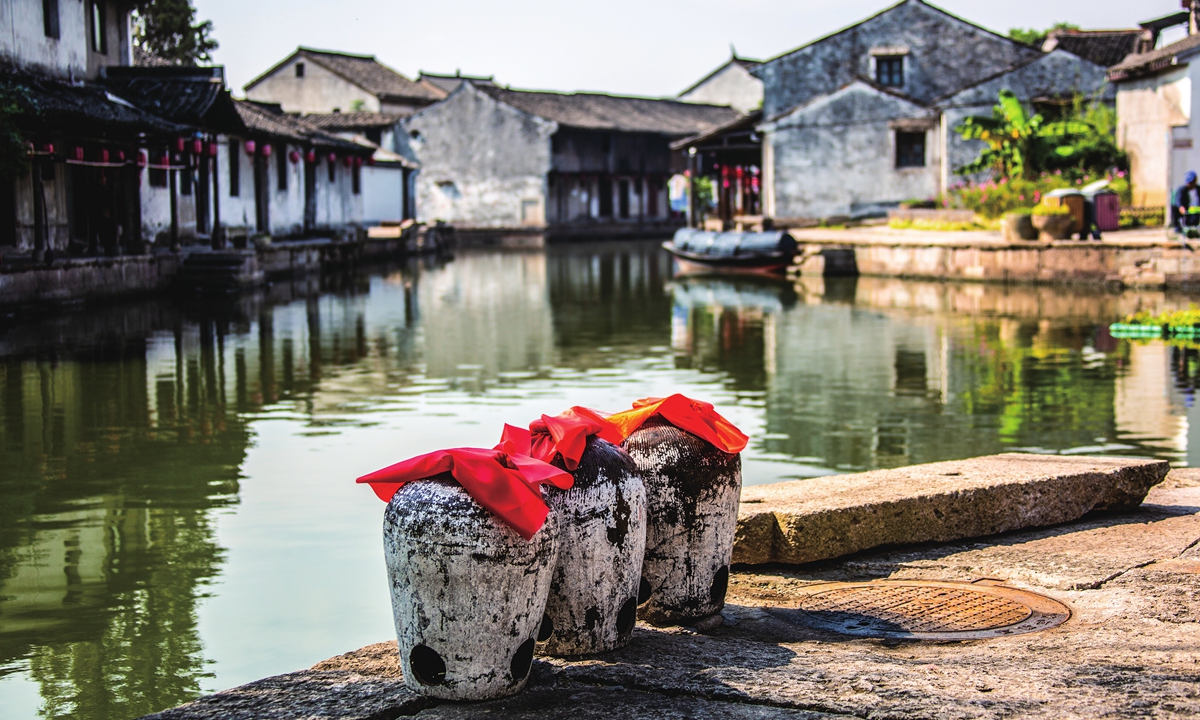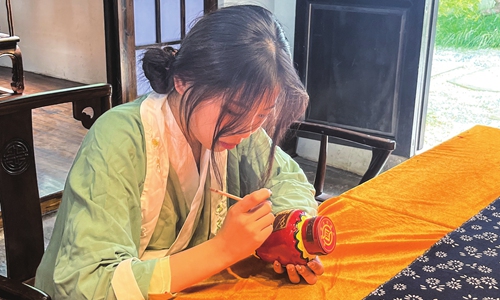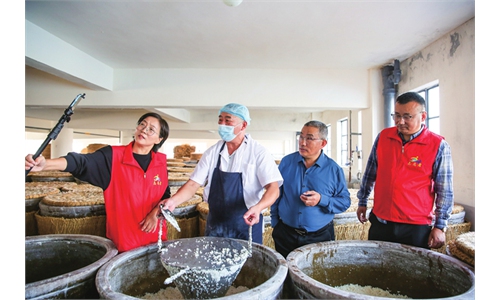ARTS / CULTURE & LEISURE
Savoring timeless elegance of Shaoxing rice wine
A winter elixir

Shaoxing Rice Wine Town in East China's Zhejiang Province Photo: VCG

The yellow rice wine inheritor is decorating a wine bottle. Photo: Li Hang/GT
In the cold winter season, there is nothing more heartwarming than a sip of wine. In Shaoxing, East China's Zhejiang Province, as the Winter Solstice arrives, the fragrance of freshly steamed glutinous rice wafts through the wine workshops and alleys since every wine workshop is busy brewing the local specialty: Shaoxing yellow rice wine.
Just as its name suggests, Shaoxing yellow rice wineshows a predominant amber color. Shaoxing, one of the birthplaces of Chinese Yellow Wine, boasts a history of over 3,000 years, ranking alongside beer and wine as one of the world's three ancient wines. Through generations, the people of Shaoxing have intertwined their lives with yellow rice wine.
In bygone times, Shaoxing families would bury jars of yellow rice wine to celebrate a child's birth. These jars would be unearthed upon the child's marriage, serving as dowries or for entertaining guests.
Today, in Shaoxing, it is common to see wine jars at the doorsteps of households. Yellow rice wine has become the top choice for various occasions, such as daily enjoyment, festive gatherings or as a gift.
Shaoxing yellow rice wine is more than just a name,but it has become a symbol of Shaoxing, ingrained in the local lifestyle, becoming an integral part of their existence.
Aging gracefully
Yellow rice wine's roots can be traced back to the Shang Dynasty (1600BC-1046BC). Its craftsmanship evolved throughout the Qin Dynasty (221BC-206BC) and up to the Qing Dynasty (1644-1911) period, standing the test of time.
Shaoxing is one of the largest production and sales bases of yellow rice wine in China. Even today, Shaoxing wine is still produced by locals using a traditional method of brewing. The technique of brewing Shaoxing rice wine was listed as a national intangible cultural heritage in 2006.
Renowned Chinese writer Lu Xun, a native of Shaoxing, held a particular fondness for yellow rice wine, featuring the drink in many of his literary works.
A century ago, Shaoxing yellow rice wine gained international acclaim by winning a gold medal at the 1915 Panama-Pacific International Exposition in San Francisco. In May 2006, the art of Shaoxing Yellow Wine brewing was officially recognized as a national intangible cultural heritage.
There are more than 50 yellow rice wine production and operation enterprises in Shaoxing, with an industrial output value of about 5 billion yuan (about $701 million) in 2022,according to a report by the Xinhua News Agency.
Wang Jinjin, the scion of a five-generation Shaoxing yellow rice wine brewing family, told the Global Times that winter is the best season to make yellow wine as the wine crafted during winter possess the purest, most mellow, and best flavor, with the best produced in mid-winter.
As the traditional Chinese Winter Solstice, the shortest day of the year approaches, the aroma of freshly steamed glutinous rice permeates the air upon entering the wine workshop. Crafting a bowl of fine yellow rice wine demands skills and patience.
The process begins with soaking the rice in the open air for over 12 days during winter, allowing for natural fermentation. The rice is then steamed, initiating starch gelatinization and subsequent cooling for fermentation.
The mixture of water, rice, and wheat distiller yeast is stirred in the fermentation vat. Covered with a thick woven lid and a straw mat, the process commences, exposing the concoction to the ambient microorganisms in the environment—air, water, utensils, and the vat itself—all contributing to the natural fermentation. After the initial fermentation, the wine lees are transferred to clay jars and left outdoors for an extended period, typically over two months.
The subsequent stage involves additional fermentation, as the semi-finished yellow wine is poured into clay jars, covered with dried lotus leaves, loosely capped with ceramic lids, and left outdoors for 80-90 days to complete the fermentation process.
The matured wine lees are then pressed to obtain raw clear wine, which undergoes clarification and high-temperature sterilization before being sealed in clay jars. The final touch involves securing the jars with lotus leaves and bamboo strips, sealed with mud.
Thus, the result is a yellow rice wine with a rich and mellow taste, adorned with a golden hue—crafted to perfection.
Innovation
Despite its ancient roots, yellow rice wine is less well-known than its counterpart, baijiu, or liquor. Some even perceive yellow rice wine as a mere culinary seasoning. To popularize the Yellow Wine culture, the local government established the Shaoxing Rice Wine Town in 2012, situated in the ancient Dongpu Town with over 1,600 years of history. Once a thriving hub with more than 500 wine workshops, the town now boasts places of attractions like exhibition halls of wine, wine workshops, and inns.
Wang's wine workshop is located in the town. To bridge this gap and introduce yellow rice wine to a younger audience, Wang's workshop has taken various measures featuring the fusion of intangible cultural heritage and cultural tourism.
For example, visitors can transparently witness the entire process of Shaoxing wine brewing in person. For enthusiasts seeking an in-depth experience, specialized venues offer hands-on activities, from brewing to tasting to help them delve into the customs and rituals surrounding the wine.
In addition, live streaming and online videos are used to further amplify the outreach, attracting more visitors to the town.
According to Wang, these means have produced innovative yellow rice wine by-products like yellow rice wine Xiaolongbao (soup dumplings), and yellow rice wine mooncakes.
Choosing any of the quaint wine taverns in the town, sitting by the window, sipping the ages in every drop of yellow rice wine, you can savor the symphony of rich heritage.

